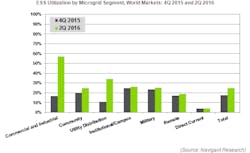Adam Wilson, of Navigant Research, describes why energy storage in microgrids is likely to become the norm. Hint: Solar microgrids are on the rise.
Energy storage systems (ESSs) have an important and diverse role in microgrids. Solar PV and other renewable distributed generation (DG) technologies require a voltage source in order to synchronize. This has typically been done with a backup generator; an ESS provides a similar voltage source but without the emissions of a diesel generator.
Recent advances in microgrid automation systems, however, have made ESSs less of a necessity in partially renewable-based microgrids. According to industry leader ABB, microgrids with as much as 50 percent of load coming from renewable sources do not need an ESS. This is 10 percent higher than previously believed.
Despite this, microgrids without some form of storage are not likely to become the norm, as ESSs provide a number of other advantages aside from being a voltage source. Peak shaving, smoothing power flow, and volt ampere reactive (VAR) support are just a few of the supplemental functions an ESS frequently serves. Islanding and black-start assistance further support the case for storage use in renewable DG microgrid systems.
The most recent update of Navigant Research’s Microgrid Deployment Tracker investigated the use of ESSs in microgrids across the globe. According to the report, of the greater than 15 GW of microgrid capacity accounted for in the Tracker worldwide, almost 25 percent utilized ESS in some form, up from a reported 17.5 percent of projects in the previous Tracker update in 4Q 2015. This is a result of ESSs being present in over 40 percent of new project capacity from the most recent update.
The chart below shows the percentage of ESS utilization by microgrid segment for both the 4Q 2015 and the 2Q 2016 Tracker. While ESS utilization grew across all categories, the commercial and industrial (C&I) and utility distribution segments saw the most significant increase, growing 40 percent and 23 percent, respectively. C&I microgrids have traditionally been led by diesel combined heat and power (CHP) systems in the past. The jump in energy storage use among microgrids in this segment likely signals a shift to solar PV and other renewable energy use that has a higher need for ESSs.
ESS Utilization by Microgrid Segment, World Markets: 4Q 2015 and 2Q 2016
This is further supported by the fact that solar PV capacity in microgrids grew by almost 840 MW since the last update of the Tracker, an increase more than five times greater than CHP capacity growth. The combination of solar PV and ESS is expected to grow in popularity across most segments and regions of the microgrid market. The declining price points of energy storage and solar PV technologies and an increasing focus on renewable sources are largely responsible for this shift. It has also been suggested that the combination of CHP, solar PV, and lithium ion energy storage represents the ideal mix of technologies for microgrids, particularly in the United States.
The high functionality of storage systems along with the growing presence of renewable generation in the microgrid market bode well for the future of ESS. These systems are expected to remain a core technology in the microgrid industry for the foreseeable future.
Adam Wilson is a research associate at Navigant Research. This blog was originally posted on Navigant’s blog.







